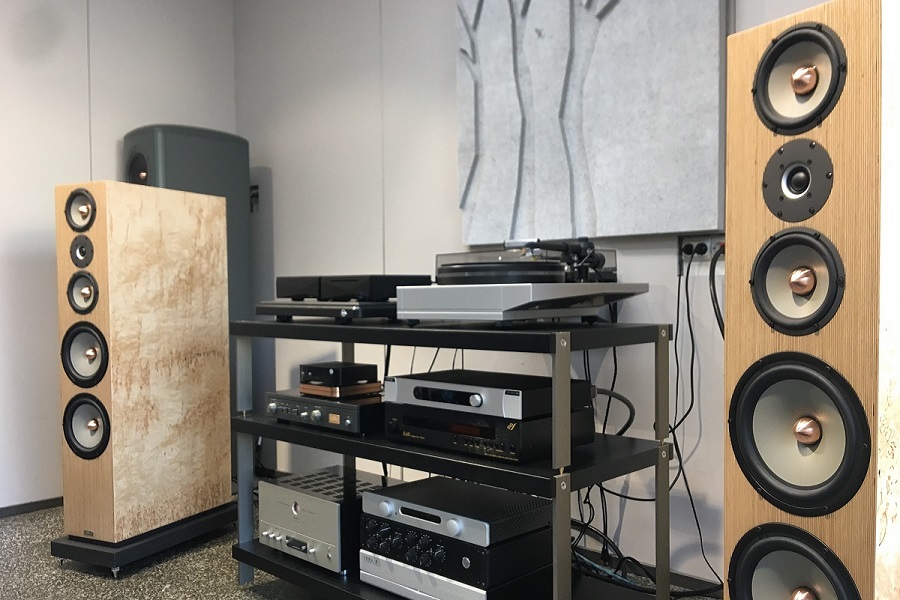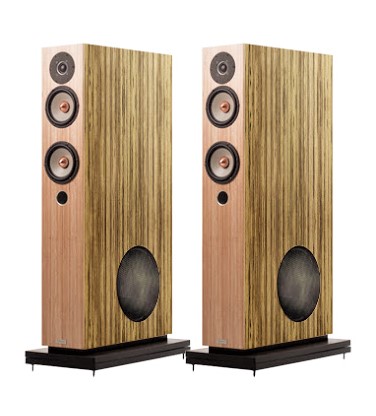I’ve been a privileged reviewer. Why? Because I’ve been able to audition all three Penaudio’s flagship models spanning over past ten years or so. None outside a dealer shop, but in circumstances that warrant forming a good preliminary opinion of their sonic performance. The prior two top models are still available for order but the latest model, Sonata Signature, stands alone on the top of the current Penaudio collection.
The Penaudio Sinfonia from 2011 was an unique loudspeaker in one respect, and the respect was this: Finland is, especially relative to the size of its population (now 5.5 million), bestowed with competent and technically advanced loudspeaker manufacturers such as Genelec, Gradient, Amphion, Aurelia etc. However, prior to Penaudio, none of them had had guts to launch a grand, physically impressive top of the range highend loudspeaker worth the name (the only exception would be the recently launched Knif-Rauman No 1.).
The 172cm high, 72kg heavy Penaudio Sinfonia was the first Finnish world-class loudspeaker that would also measure like a top-of-the-range world-class loudspeaker. All other Finnish speaker manufacturers built their international success on smaller and more practical models with a high quality sound, of course, but lacking the grandness that only the size and gesture can give.
Penaudio too began its conquest of world markets with compact and cleverly designed speaker models, but in less than ten years felt ready to take a bigger step, and launch a true high-end loudspeaker to compete among heavyweights.
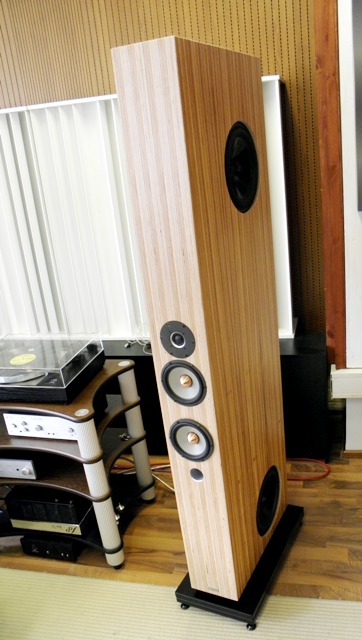
Penaudio Sinfonia
It was early 2010s that Penaudio’s head designer Sami Penttilä took the bull by the horn, and designed a speaker that was published in 2011. It was the sort of speaker he had always been dreaming of, a speaker into which he loaded everything he had learned by then, directly or indirectly, of speaker design and manufacturing: The Sinfonia.
The Sinfonia is a 3,5 way design with two custom made 160mm Seas Excel midrange/woofers with a magnesium cone, and other technical finesses. The tweeter is the 29 mm Seas Crescendo, ferrofluid cooled textile dome, with a hexadym magnet system, and a shallow waveguide to smoothen out tiny irregularities of the response. This was the first time Penaudio used the Seas Crescendo as the tweeter in its models.
Initially the idea was to use Seas Excel woofers, but despite numerous experiments, Sami Penttilä didn’t get the sort of bass sound that he was after. So he ended up with a standard 260mm Seas paper cone woofer with a 4 layer voice coil.
“For some reason paper cone woofers are able to produce that genuine rugged and coarse bass sound that I like. I guess that is why the best bass guitar amplifiers come with paper cone woofers. In addition, in the case of Sinfonia the Excel-series woofers would not have benefitted the midrange where distortion becomes subjectively a bigger issue.”, Penttilä explains the choice.
Each placed in a separate 50L cabinet, the side-woofers are asked to produce frequencies below 80Hz, the one low passed at 200Hz, the other reproducing frequencies up to 4500Hz where the Seas Crescendo tweeter takes over: “In this way I could also control a little bit the speaker’s directivity in the area where it matters most, between 100 and 500Hz, and address the issue of baffle step. A pure 3-way would have produced a way too much of upper bass and lower mids. Now the bass is much cleaner, tighter and more articulate.”
The then roughly 20 000 euro Sinfonia holds strong resemblance with the narrow/tall Penaudio look, featuring the same typical-to-Penaudio ply stripe finish on side panels as other models. The enclosure was made of 19mm plywood (side panels) and 22mm MDF of the front, rear, top and bottom panels. Special damping measures were applied all over inside the cabinet. Also, the cabinet for the mid/bass drives was made asymmetrical to lessen the impact of internal resonances (also those of the bass cabinet).
Component selection was familiar from the other Penaudio models: Jorma Design and Graditech cables, WBT Next Gen binding posts, SCR caps.
The listening took place at Sound Factor in Tampere. The somewhat irregular listening room was 35m2 (5m x 7m). The Sinfonia was driven by the mighty EAR M100A mono blocks, or alternatively EAR 509 mono blocks. The CD player was EAR Acute 3, the preamp EAR 912.
Penaudio Sinfonietta
The next Penaudio flagship model was Sinfonietta, a reflex loaded 3,5-way floorstander. Imagine that the Sinfonia is cut in half just above the 29mm textile, ferrofluid cooled dome tweeter (with a hexadym magnet system), and what you get is the 50kg Sinfonietta. It’s depth is almost half of its height (113 cm), which gives the speaker audiophilia kind of believability. In fact, Sinfonietta should not be considered a little brother of Sinfonia, but a twin brother of a different shape.
The front panel is narrow (18 cm), as it always is in Penaudio’s speakers, leaving music to float “in the air” between the speakers. The midrange/woofer is 160mm magnesium coned driver with copper rings above and below T-shaped pole piece, and radial reinforced rubber surround. The woofer at the bottom of the side panel is 260mm paper coned driver with a 4 layer voice coil. All the drivers are the same SEAS custom/excel drivers as in the Sinfonia.
The internal wiring is by Jorma Design, binding posts WBT-0705 Ag (silver, Next Generation), SCR polypropylene capacitors are used in the crossover as well as Graditech air-core inductors. The cross-over points are 85Hz, 200Hz, and 4500Hz. The reflex ports are made of aluminium, and the cabinet finish custom made birch plywood 19mm + 22mm MDF.
The sensitivity is 86dB/1m/2.83V, nominal impedance 8 ohms. The said frequency range in an anechoic chamber goes from +-3dB 30 to 30000Hz, and in a room 20-25000Hz. This last piece of info on the in-room response is important because Penaudio strongly beliefs that there are rooms and there are rooms, and there are speakers that go well with one room, but not with another. Thus, one ought to be very careful about choosing a right kind of speaker to the room in question.
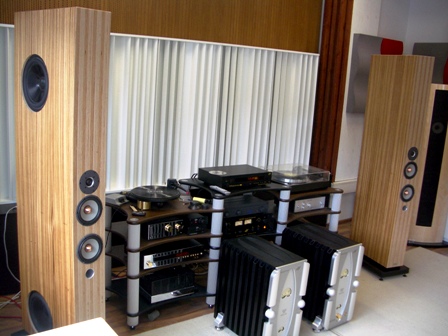
Sound of Sinfonia and Sinfonietta
Penaudio Sinfonia was specifically made for very large rooms and auditoriums in the very concrete sense that if dragged to smaller rooms, they are bound to or at least very likely to be anything but bass shy. And that was exactly what took place when I first heard them in a dealer shop, which was not a small space but still not what could be regarded as a large living room: many excellent features of the sound (well-tempered midrange, majestic soundstage etc.) were partly masked by superfluous energy over the bass frequencies and lower midrange. That it, the bass department was eloquent and powerful but also quite abundant (compared briefly with Avalon Indras).
Compared to this, the bass of the Sinfonietta, appeared to be more modestly measured, ie. better adjustable to smaller rooms (even though the volume of the demo room where I heard them wasn’t that low), and my hunch was that the better controlled and defined bass of the Sinfonietta wasn’t just due to having only one side woofer per channel instead of the two in Sinfonia. It was simply differently tuned.
Otherwise, the size of the sound of the Sinfonia, its height and depth, and weight, was remarkable. The speaker has huge lungs and as a consequence, treated eg. vocal and orchestral music very well indeed. The sound was natural, easy-going and unstressed. Not unlike other Penaudio speakers, the midrange was clean, clear, open, smooth, and – gentle. This almost magical quality of the sound must have something to do with the fact that the mid/woofers cover almost six octaves, and the way in which they do it. The treble appeared to be seamlessly integrated with the midrange, and upper harmonics were reproduced in a refined manner. Listening to violins revealed that the Sinfonia emphasizes sophistication and elegance over concreteness and presence.
The Sinfonietta too performed openly, smoothly and pleasantly, both tonally and spatially. Sinfonietta may lack the grandness of the Sinfonia but it will certainly be able to deliver a similar sonic performance with respect to almost every relevant aspect of the sound. And without hesitation I can recommend the Sinfonietta for those who wonder whether the speaker provides quality time with all or just some sorts of music. No musical discrimination here. Friends of Penaudio will not be disappointed, in particular because the asking price of the Sinfonietta is just 65% of the price of the Sinfonia.
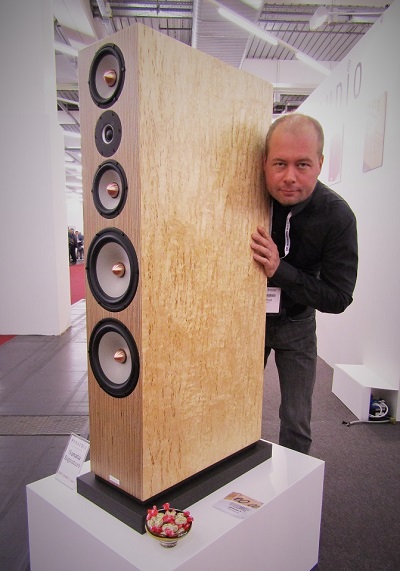
Sonata Signature
Let’s repeat. The Penaudio Sinfonia sounded grandiose but abundant in bass, at least in a medium-size room, so much so that time to time it was difficult to tell what the true tonal nature of the speaker was. Comparatively, the Penaudio Sinfonietta, in a room not too different from the first one, was a way more restrained and accurate in bass, both speakers, in other sonic considerations, showing similar qualities, and a high performance level. Which brings us to the Penaudio’s new flagship model in the Signature line: Sonata Signature.
I think it’s not incorrect to conceive it as an attempt, with a completely new design, to take the best of both worlds, Sinfonia and Sinfonietta.
Physically the 24 980 € and 124 cm tall (W 240 x D 550 mm) Sonata Signature is closer to the Sinfonietta than the Sinfonia. The speaker sports top-notch SEAS drivers: 29 mm soft dome Crescendo tweeter, 2 x specially made for Penaudio 145 mm aluminum/magnesium midrange/woofer, and 2 x 220 mm aluminum/magnesium woofers, also specifically made for Penaudio, both with Excel motors. The units are crossed at 180 and 4000 Hz.
The tweeter has a powerful magnetic system Hexadim, which consists of radially located neodymium magnetic blocks, allowing minimizing the reflection of sound waves in the back of the diaphragm and providing ventilation for the voice coil; ferromagnetic liquid is used for cooling.
The speaker is encased with multilayer panels of Finnish birch plywood and MDF. The combination ensures acoustically inert cabinet with excellent damping characteristics and immunity to unwanted vibrations, resulting in ”a clearer, more accurate and natural sound free of any coloration”. And as always, Penaudio reports that listening tests and fine tuning the sound took a long time before they were pleased with the final sound.
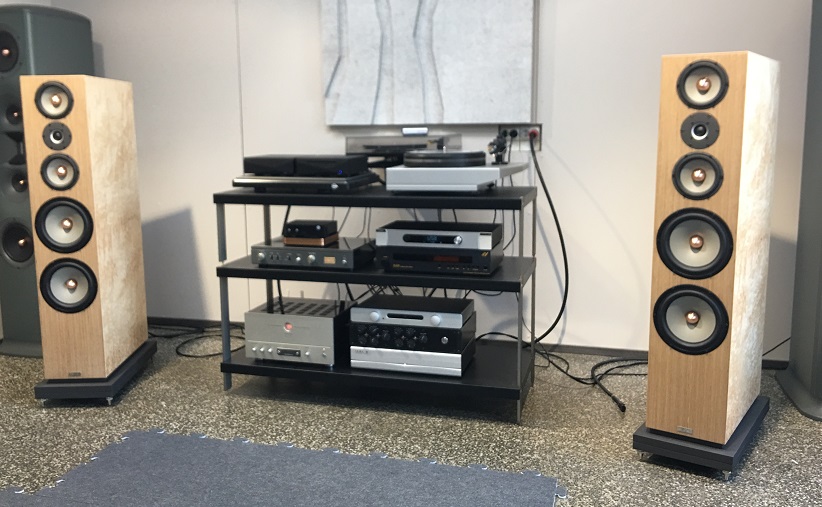
The demo room was the same reasonably sized space where I first heard the Sinfonia, with parallel walls but the rear of the room opening up to an extra space. I got a warning about the room mode at 40Hz, but in practice, and with my sample recordings, the said frequency didn’t pose a problem of any significance. The speakers were driven by one of Air Tight’s tubed power amps. The dealer, who had much more experience of the speaker than I do, told that the Sonata Signature likes power and amp control, and that ideally some solid state amp high-current power amp might have been more apt to the job.
All that I can tell is that even with the tube watts the Sonata Signature’s resolution at bass frequencies sounded to be better (more transparent) than with the Sinfonia and Sinfonietta, to the extent that I can remember, which can be a function of better overall resolution or some other factor, but naturally the quick two hour listening session does not allow me to confirm neither the rightness of my perception, nor the correct reason for the result, if true.
Engineering-wise, the decision to give up the side woofers and place smaller ones on the front baffle, should not make a big difference, given the speaker is correctly designed in other regards. But there may be some subjective factors related to the visual appearance of the speaker that can possibly have an effect on the subjective evaluation of the sound, and the visible front-firing woofers can affect the subjective assessment in this way. And of course, there are hobbyists who stick to the claim that front-woofers do their trick in a more direct and physical way. At any rate, the woofers of the Sonata Signature seemed to work well not only over their own frequency band, but also by being in a fine harmony with the drivers above them. Penaudio has certainly made a major effort to filter the woofers, and in aligning their energy with the output of the midrange units.
More distinctively, I got the impression that the Sonata Signature kind of held back (eg. Baroque opera), but that it did it expressively and soulfully. The tonal balance showed musical smoothness, and the timbres of various instruments gave no much reason to complain. Curiously enough, the overall sound appeared to be, independently of the program material, slightly bass dry, making the sound lack that juicy warm character, which I associate with Penaudio. Penaudio itself speaks about the “natural and free-flowing” sound that promotes the listeners’ “auditory wellbeing”. The essence of this quality is not easy to pin down. It is a kind of softness, and yet it is not. It’s not pure warmth either. Politeness, maybe. Restfulness? Pleasant it is, certainly. Gentle.
Gentle the sound is still and heart-warming in that peculiar Penaudio way, but something made me think that this time Sami Penttilä had wanted to design a speaker that refuses to show off, and instead, be more neutral, more two-sided, more serene and avoid all kind of empty sensationalism that some similar speakers on the market are prone to. If this finding is correct, the solution can well be argued for, and was largely supported by my music samples, just leaving a track or two missing the mellow character of the midrange. All in all, popping in a dealer shop for the quick trial of the Sonata Signature, left an impression of a loudspeaker whose highly appealing sound is of absolute top-class quality.
Penaudio Sonata Signature
Type: 3-way, reflex loaded, floorstander
Drive units: 29 mm soft dome tweeter, ferrofluid cooled (Seas Crescendo), 2 x Specially for Penaudio 145 mm alu/magn midrange/woofer (Seas Excel), 2 x 220 mm Specially for Penaudio alu/magn woofer (Seas Excel)
Cross-over: 180, 4000 Hz
Frequency range in room response: 25 – 30000 Hz
Sensitivity: 89 dB/1 m/2,83 V
Nominal impedance: 4 Ohms
Recommended amplifier: >30 W
Bottom platform size: 300 x 610 mm
Weight: 59 kg
Specialities: Top of Signature line, 3-way floorstanding, special woofers by SEAS for Penaudio, copper ring and brass bullet, Excel motor system, one of the best SEAS excel tweeter CRESCENDO, WBT Nextgen 0705AG silver connectors, silver plated wires, luxury parts hand wired crossover, special Sami Penttila Signature plate, magnet grill


